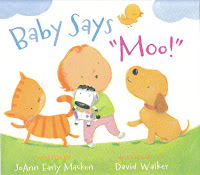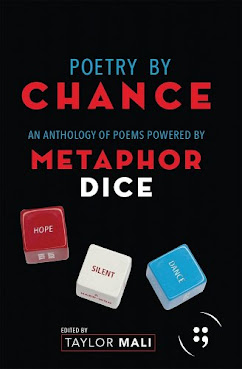Wednesday, March 2, 2011
Picture Book Lesson #3, Dr. Seuss’s Birthday, & Book Giveaway!
Posted by
JoAnn Early Macken
It's Baby Says, “Moo!” Week at Teaching Authors.com! To celebrate the publication of my new rhyming picture book, we’re giving away an autographed copy. Entry details below!
Today, we also celebrate the birthday of beloved children's book author Dr. Seuss. I'll always remember my mother reading The 500 Hats of Bartholomew Cubbins to my sisters and me. Our kids loved Dr. Seuss's ABC, Fox in Socks, and One Fish Two Fish Red Fish Blue Fish. Join the nationwide birthday celebration by taking part in the National Education Association's Read Across America Day.
As my contribution to the picture book topic the other Teaching Authors have already addressed, I’m sharing some lessons I learned by looking back at the writing and publishing process for each of my five picture books. I’ll post one each day this week.
I learned how to research nonfiction by writing dozens of nonfiction books for beginning readers. Educational publishers assigned the titles and published them in series. I enjoyed the research process, so I decided to write a nonfiction book on a topic I chose myself. I also wanted to break away from strict rules about reading levels and sentence structures. Flip, Float, Fly: Seeds on the Move, a nonfiction picture book about the many ways seeds travel, was the happy result of both my longtime love of plants, trees, and gardens and my desire to write nonfiction in a creative, poetic way.
Lesson #3: Write about what you care about.
Baby Says “Moo!” Giveaway
Booklist says, “Everything about this picture book—concept, story, appealing art—is pretty much perfect for the two-and-under set. . . . The cumulative text is written in nicely scanning (and delightful!) rhyme that toddlers will enjoy. Fruit-juice colors and people and animals drawn in the rounded shapes of stuffed toys dominate the spreads, except in the sidebars of accumulating tweets and meows.”
Because picture book authors and illustrators typically have no contact during the illustration process, submitting a picture book manuscript requires an author to let go and trust the editor's knowledge of the field and the illustrator's ability to interpret and expand on the text. I'm happy to say that David Walker’s adorable illustrations not only fit the text perfectly but also include delightful details that help tie the story together and move it forward while entertaining readers of all ages.
To enter the drawing for an autographed copy of Baby Says “Moo!”, follow these steps:
1. Post a comment on any post this week and tell us about a learning game you’ve played with children. Enter only once, please!
2. Include your contact information in your comment. If you are not a blogger or your e-mail address is not accessible from your online profile, provide a valid e-mail address in your comment. Feel free to disguise your address by spelling out portions, such as [at] and [dot].
3. Post your comment by 11 p.m. (CST) Monday, March 7, 2011.
The winner:
• must have a mailing address in the United States.
• will be determined using the random number generator at Random.org.
• will be announced on Tuesday, March 8.
• automatically grants us permission to post his or her name on our Teaching Authors web site.
• will also be notified by e-mail.
• must respond to the notification e-mail and provide a mailing address within 72 hours, or the prize will be forfeited and an alternate winner will be chosen.
Good luck!
JoAnn Early Macken
Today, we also celebrate the birthday of beloved children's book author Dr. Seuss. I'll always remember my mother reading The 500 Hats of Bartholomew Cubbins to my sisters and me. Our kids loved Dr. Seuss's ABC, Fox in Socks, and One Fish Two Fish Red Fish Blue Fish. Join the nationwide birthday celebration by taking part in the National Education Association's Read Across America Day.
As my contribution to the picture book topic the other Teaching Authors have already addressed, I’m sharing some lessons I learned by looking back at the writing and publishing process for each of my five picture books. I’ll post one each day this week.
I learned how to research nonfiction by writing dozens of nonfiction books for beginning readers. Educational publishers assigned the titles and published them in series. I enjoyed the research process, so I decided to write a nonfiction book on a topic I chose myself. I also wanted to break away from strict rules about reading levels and sentence structures. Flip, Float, Fly: Seeds on the Move, a nonfiction picture book about the many ways seeds travel, was the happy result of both my longtime love of plants, trees, and gardens and my desire to write nonfiction in a creative, poetic way.
Lesson #3: Write about what you care about.
Baby Says “Moo!” Giveaway
Booklist says, “Everything about this picture book—concept, story, appealing art—is pretty much perfect for the two-and-under set. . . . The cumulative text is written in nicely scanning (and delightful!) rhyme that toddlers will enjoy. Fruit-juice colors and people and animals drawn in the rounded shapes of stuffed toys dominate the spreads, except in the sidebars of accumulating tweets and meows.”
Because picture book authors and illustrators typically have no contact during the illustration process, submitting a picture book manuscript requires an author to let go and trust the editor's knowledge of the field and the illustrator's ability to interpret and expand on the text. I'm happy to say that David Walker’s adorable illustrations not only fit the text perfectly but also include delightful details that help tie the story together and move it forward while entertaining readers of all ages.
To enter the drawing for an autographed copy of Baby Says “Moo!”, follow these steps:
1. Post a comment on any post this week and tell us about a learning game you’ve played with children. Enter only once, please!
2. Include your contact information in your comment. If you are not a blogger or your e-mail address is not accessible from your online profile, provide a valid e-mail address in your comment. Feel free to disguise your address by spelling out portions, such as [at] and [dot].
3. Post your comment by 11 p.m. (CST) Monday, March 7, 2011.
The winner:
• must have a mailing address in the United States.
• will be determined using the random number generator at Random.org.
• will be announced on Tuesday, March 8.
• automatically grants us permission to post his or her name on our Teaching Authors web site.
• will also be notified by e-mail.
• must respond to the notification e-mail and provide a mailing address within 72 hours, or the prize will be forfeited and an alternate winner will be chosen.
Good luck!
JoAnn Early Macken
Subscribe to:
Post Comments (Atom)













3 comments:
I play "20 Questions" with my 2 daughters on long car drives, waiting for our food at restaurants, anywhere really.
Thanks for the Lessons...I enjoy your blog.
Bridget Magee
Thanks, Bridget! Your comment reminds me of another game we played during long car rides: searching for letters and numbers in license plates.
When I was a kindergarten teacher, I played "What's in the box" with the children. They would put their hand in a box, feel an object, and describe it to their classmates, who would try to guess what the object was. This was an exercise in increasing vocabulary. Later in the year, I would put rubber letters and numbers in the box. They loved this game!
Check out my blogs at: RhodeSoft.blogspot.com AND ToniRhodes@blogspot.com.
Post a Comment